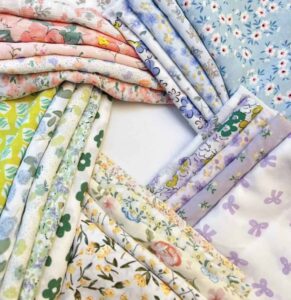Thermal transfer imaging technology has been used in textile printing for decades, and with the integration of high technology, thermal transfer technology has been used in many fields. Currently, thermal transfer technology is widely used in the financial, transport, tourism, commercial, postal and telecommunications, office automation and textile industries. The current characteristics of heat transfer printing are strong colour fastness of the image, not easy to crack, wear resistance, no fading, but there are still certain disadvantages, that is, if the natural and chemical fibre fabrics use heat transfer printing, two special transfer paper and transfer ink, even digital printing (can be printed on different nature of the fabric) also reflects certain disadvantages, that is, digital printing ink rheology and Even digital printing (which can be printed on fabrics of different nature) has certain disadvantages, namely the rheology and adaptability of digital printing inks, which can lead to decolourisation, and the high cost of the machines, which are not easy to produce in small quantities. Based on the above problems, experiments and research were carried out on the rheological properties of thermal transfer printing, the diffusion properties of the substrate and the adaptability of the printing, with the aim of developing a thermal transfer ink with accommodating properties.
Study of the flow properties of thermal transfer inks
The flow properties of thermal transfer inks are mainly reflected in the diffusion properties of the substrate surface and the formation of a uniform and smooth ink layer on the surface. The fluidity of thermal transfer inks is also a general expression of the ink’s rheological properties, which are expressed in terms of viscosity, colour fastness, yield value and thixotropy, which are also important performance indicators for thermal transfer inks. If the thermal transfer ink is to have a certain degree of compatibility with fabrics of different compositions, it is important that the ink’s viscosity, alternating stress, thixotropic and rheological properties
The relationship between tensile deformation and viscous flow of the ink is studied and experimented.

Experiments on the flow properties of thermal transfer inks
Experimental materials
The purpose of the experiment was to test the applicability of rheological properties to the accommodation of fabrics. The ink is suitable for use on various offset printing machines, screen printing machines, digital printing machines, etc. It is made of environmentally friendly raw materials and has a bright colour. The basic composition of this brand of ink is shown in Table 1, the temperature required for the transfer is shown in Table 2 and the sunlight resistance is shown in Table 3.
Table 1 Basic composition of thermal transfer inks
Table 2 List of temperatures required for the transfer of thermal transfer inks
Table 3 Sunlight resistance of thermal transfer inks (grade)
Experimental equipment
The ink fluidity was measured using a plate high temperature viscometer, the paper was measured using an IGT printability meter AIC2-5T2000 and the ink density was measured using a 530 spectrophotometer .
Test method for the flow properties of thermal transfer inks
Before testing the rheological properties of the thermal transfer inks, the ink samples were stirred for 10 min at a shear rate of 60 s-1 and then left to stand for 10 min at 25 °C. In the test, an external force is first applied to the sample in a certain direction and the shear rate is recorded. The stress is then increased and the procedure is repeated. When the stress is increased to 5 Pa, the viscosity of the sample ink is on average four orders of magnitude higher than the other inks and thins out at higher shear. The thixotropic properties of the material were determined by testing the increase and decrease in stress with shear rate.
The ink samples were mixed for consistency, the flow properties of the ink were measured using a flat sheet viscometer, the paper was measured using an IGT printability meter AIC2-5T2000 and the density of the thermal transfer ink was measured using a 530 spectrophotometer, immediately after stirring for 10, 15 and 20 minutes. The ink samples were left to stand for 10 minutes or more and then the flow properties were measured to better determine how to improve the transfer ink’s accommodation properties.

Experimental results and analysis of the thermal transfer ink accommodation properties
Influence of the viscosity and printability of flux inks
The flow of ink fluids is characterised by internal friction, a resistance to movement caused by the mutual attraction of the molecular structures in the fluid. The relationship between ink viscosity and shear rate is shown in Figure 1.
3. 1. 1 Experimental analysis of thermal transfer ink fluidity
1. The curve of the flow properties of thermal transfer inks is not linear The law of viscosity flow.
2. the viscosity of the ink becomes progressively lower as the shear rate increases.
3. the increase in shear rate reduces the agglomeration of the pigment, which results in a change in the dispersion of the pigment in the internal structure of the ink and therefore a certain improvement in the dispersion of the pigment.
4. The ink has a certain number of values at high shear rates, which indicates a certain dynamic dispersion of the pigment particles in the ink structure Balance Shear rate/s-1
Figure 1 Relationship between ink viscosity and its rate
3. 1.2 Analysis of experimental results on the viscosity of thermal transfer inks
When transferring inks to substrates, the viscosity of the ink affects the quality of the transfer print (including colour fastness). In the course of experiments it was found that too high a viscosity of the ink sample resulted in poor transfer of the ink onto the transfer paper base or substrate, as reflected by poor colour uniformity of the ink. During the study, it was found that the flow properties of the ink gradually increased when the ink viscosity became low. As shown in Table 4, if the viscosity value is small, diffusion occurs on the surface of the substrate. It can be seen that the density of the ink varies in relation to the ink viscosity, as shown in Figure 2.
Table 4 Relationship between ink viscosity and flowability
Viscosity/ (Pa – s )
Fig. 2 Relationship between solid density of the print and ink viscosity
Influence of the elasticity of the thermal transfer ink on the print adaptability
Thermal transfer inks have a certain viscous reaction in the process of mounting, which is not only related to the ink particles, but also to the elasticity factor. The viscoelastic adaptation of the ink to shear and tensile forces is shown in Fig. 3, which shows that the dynamic viscous film volume decreases with increasing angular frequency, while the storage elastic modulus increases slowly with increasing angular frequency. The storage modulus at an angular frequency of 1.5 rad/s The modulus of elasticity, dynamic viscous modulus and strain curves are shown in Figure 4. Figure 4 reflects the experimental results and shows that both the storage modulus and dynamic viscous modulus shrink with increasing strain and have a corresponding downward trend, i.e. the storage modulus and dynamic viscous modulus are relatively flat when the strain is less than 2.0%. The experiments show that the modulus of storage elasticity and dynamic modulus of elasticity decrease with increasing strain when the strain is greater than 2.0%. The experimental results show that the linear elastic region of the ink system is a small strain region with a strain amplitude of less than 2.0%.
Angular frequency / (rad – s-1 )
Fig. 3 Dynamic viscoelasticity as a function of angular frequency Strain/%
Fig. 4 Dynamic viscoelasticity versus strain
Proposed formulation and preparation method for a solvent-based thermal transfer ink
Materials used in flux inks and their formulations
The ink consists of the following weight percentages of components: 20%-25% chloroethylene vinyl acetate resin, 0-3% dispersant, 15%-20% synthetic wax, 25%-30% ground wax, 17%-25% colouring matter, 10%-15% turpentine, 1.5%-2.5% additives, 1%-3% high boiling point alkyl alcohol, 0.5%-1% dummy powder, 10%-15% castor oil. . For ink materials and formulations, see Table 5.
Table 5 Ink components and their ratios
Preparation of fluxing inks
Mix all the components, except the colouring matter, together in a container and stir until melted. All the ingredients are immediately transferred to a grinder and ground until the colour has reached a particle size of 20 μm or less. The rolled mixture is poured into a dispersing machine with a capacity of 20-50 L at a speed of 800-1,200 r/min and heated to approx. 1,000 °C in the electric furnace of the dispersing machine to melt it completely.
Conclusion
After testing the rheological properties, consistency and printability of the inks, the key issue was to be able to use the same ink to transfer to transfer paper or normal printing paper using a printer or screen printing method, and thus to transfer to chemical and natural fibre fabrics.
The molecular structure of the ink (rheology of the ink) was tested and the viscosity of the sample ink was on average four orders of magnitude higher than other inks and thinned at higher shear. The thixotropic properties of the material were determined by testing the increase and decrease in stress with shear rate . Based on these experiments, a method was found to allow the ink to adhere to natural and chemical fibres by changing the molecular structure of the paper base. Thermal transfer inks are made up of linkers, colours and chemical additives, which are composed of wax-based linkers and resin-based linkers . The wax-based linker plays an important role in the ink. After the thermal transfer ink has been applied to the surface of the substrate, the wax floats on the surface of the ink layer and acts as an anti-scuffing agent. The thermal transfer pulp is mixed with melamine, rosin, bauxite and talc, and the paper surface is largely composed of silicone and polyvinylic acid.
As the paper base is not molten, we can add an appropriate amount of polyethylene wax powder to the paper base (transfer paper), which causes the wax film to dissolve during the thermal transfer process, allowing the ink to transfer to the surface of the substrate. The choice of wax should be based on the characteristics of the ink, the substrate material, the range of melting points, oil content, gloss and acid value .
The experiments on the elasticity of thermal transfer inks in relation to the printability of the inks show that the storage modulus and the dynamic viscosity modulus both decrease with increasing strain, and that the dynamic viscosity rate decreases more rapidly than the storage elasticity rate, showing the characteristics of non-linear viscoelasticity, so that according to this experiment it is possible to find ways to improve the permeability of thermal transfer inks in a heated state . Thermal transfer inks are a new type of ink which differs greatly from ordinary inks in that they are first attached to a base paper (transfer paper) and then the required part of the ink layer is transferred to the surface of the object to be printed by heat, whereas ordinary inks are printed in a single pass and therefore the quality requirements of the ink differ greatly. For example, the greater the adhesion of ordinary ink, the better, while the adhesion of thermal transfer ink must be moderate, too large for the transfer process, too small for the ribbon to be deinked (scrap) and too poor for the ribbon to adhere to after transfer . The degree of polymerisation and the proportion of monomer polymerisation affect the modulus of elasticity and the dynamic modulus of adhesion, so that the ink can be transferred to different forms of textile materials. Note that the technology is not yet perfect and is not yet available in the exact amount of raw materials to be used in the formulation needs to be analysed according to the actual situation. The study of the compatibility of thermal transfer inks is not yet complete It still needs to be verified in concrete production .
























